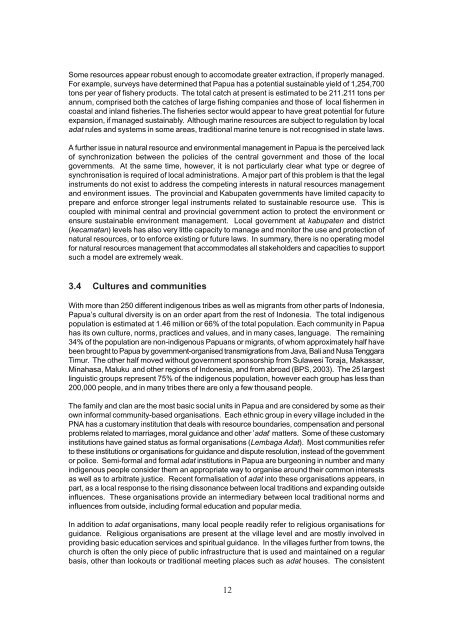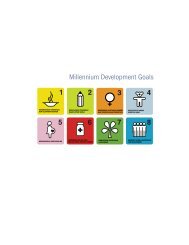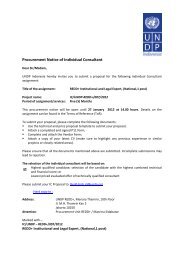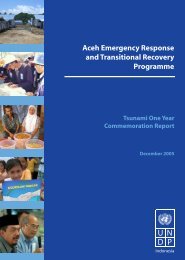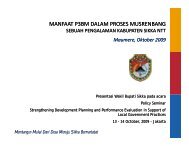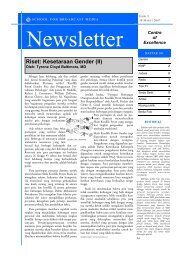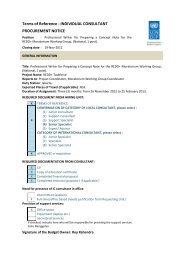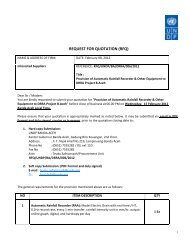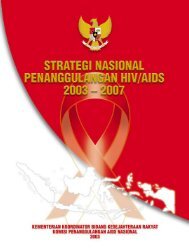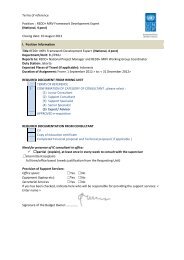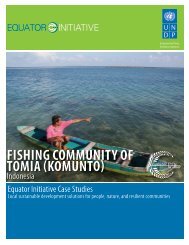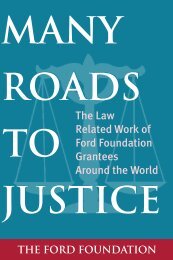Papua Needs Assessment - UNDP
Papua Needs Assessment - UNDP
Papua Needs Assessment - UNDP
You also want an ePaper? Increase the reach of your titles
YUMPU automatically turns print PDFs into web optimized ePapers that Google loves.
Some resources appear robust enough to accomodate greater extraction, if properly managed.<br />
For example, surveys have determined that <strong>Papua</strong> has a potential sustainable yield of 1,254,700<br />
tons per year of fishery products. The total catch at present is estimated to be 211.211 tons per<br />
annum, comprised both the catches of large fishing companies and those of local fishermen in<br />
coastal and inland fisheries.The fisheries sector would appear to have great potential for future<br />
expansion, if managed sustainably. Although marine resources are subject to regulation by local<br />
adat rules and systems in some areas, traditional marine tenure is not recognised in state laws.<br />
A further issue in natural resource and environmental management in <strong>Papua</strong> is the perceived lack<br />
of synchronization between the policies of the central government and those of the local<br />
governments. At the same time, however, it is not particularly clear what type or degree of<br />
synchronisation is required of local administrations. A major part of this problem is that the legal<br />
instruments do not exist to address the competing interests in natural resources management<br />
and environment issues. The provincial and Kabupaten governments have limited capacity to<br />
prepare and enforce stronger legal instruments related to sustainable resource use. This is<br />
coupled with minimal central and provincial government action to protect the environment or<br />
ensure sustainable environment management. Local government at kabupaten and district<br />
(kecamatan) levels has also very little capacity to manage and monitor the use and protection of<br />
natural resources, or to enforce existing or future laws. In summary, there is no operating model<br />
for natural resources management that accommodates all stakeholders and capacities to support<br />
such a model are extremely weak.<br />
3.4 Cultures and communities<br />
With more than 250 different indigenous tribes as well as migrants from other parts of Indonesia,<br />
<strong>Papua</strong>’s cultural diversity is on an order apart from the rest of Indonesia. The total indigenous<br />
population is estimated at 1.46 million or 66% of the total population. Each community in <strong>Papua</strong><br />
has its own culture, norms, practices and values, and in many cases, language. The remaining<br />
34% of the population are non-indigenous <strong>Papua</strong>ns or migrants, of whom approximately half have<br />
been brought to <strong>Papua</strong> by government-organised transmigrations from Java, Bali and Nusa Tenggara<br />
Timur. The other half moved without government sponsorship from Sulawesi Toraja, Makassar,<br />
Minahasa, Maluku and other regions of Indonesia, and from abroad (BPS, 2003). The 25 largest<br />
linguistic groups represent 75% of the indigenous population, however each group has less than<br />
200,000 people, and in many tribes there are only a few thousand people.<br />
The family and clan are the most basic social units in <strong>Papua</strong> and are considered by some as their<br />
own informal community-based organisations. Each ethnic group in every village included in the<br />
PNA has a customary institution that deals with resource boundaries, compensation and personal<br />
problems related to marriages, moral guidance and other ’adat’ matters. Some of these customary<br />
institutions have gained status as formal organisations (Lembaga Adat). Most communities refer<br />
to these institutions or organisations for guidance and dispute resolution, instead of the government<br />
or police. Semi-formal and formal adat institutions in <strong>Papua</strong> are burgeoning in number and many<br />
indigenous people consider them an appropriate way to organise around their common interests<br />
as well as to arbitrate justice. Recent formalisation of adat into these organisations appears, in<br />
part, as a local response to the rising dissonance between local traditions and expanding outside<br />
influences. These organisations provide an intermediary between local traditional norms and<br />
influences from outside, including formal education and popular media.<br />
In addition to adat organisations, many local people readily refer to religious organisations for<br />
guidance. Religious organisations are present at the village level and are mostly involved in<br />
providing basic education services and spiritual guidance. In the villages further from towns, the<br />
church is often the only piece of public infrastructure that is used and maintained on a regular<br />
basis, other than lookouts or traditional meeting places such as adat houses. The consistent<br />
12


